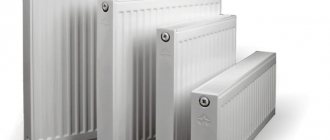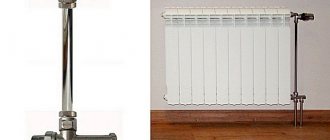Operating principle of a vacuum heating device
Hot water flowing from the heating system to the bottom of the radiator (connected to the heating system using standard couplings) transfers heat to the lithium bromide fluid. It quickly begins to evaporate, heating all sections of the radiator. The condensate flows down, then again turns into steam and rises up. Thus, the outer wall of the pipe, adjacent to the coolant, is constantly cooled. And the temperature difference between its inner and outer surfaces increases the heat flow.
Radiator sections, heated by hot steam in a couple of minutes, release heat to the surrounding air. Moreover, according to manufacturers, this happens instantly. The heat transfer they claim for one section of this device is 300 watts, and a very small amount of water is used. These are serious numbers - next we will try to find out if this is so. And at the same time we’ll check how wonderful the new heating devices are.
How to choose vacuum heating batteries
The very first step is to check the distribution network and all the necessary quality certificates. Reviews of stores are easy to find on the Internet, and there are also sample certificates. If the store does not have any documents, you should not make a purchase.
Then you should find out the temperature regime of the device. If the instructions indicate 110-120 °C, then when installing a radiator in an apartment with central heating, you can forget about the declared performance. According to standards, the coolant temperature for residential premises reaches 90 °C, and for effective operation of lithium-bromide liquid, a range of 40-60 °C is needed. It is under these conditions that it reaches the fog stage, which ensures maximum heat transfer.
Things to check during purchase:
- Availability and quantity of working fluid. To do this, rock the radiator slightly from side to side. There should be a slight rustling sound. If a distinct splashing sound is heard, there is too much liquid. If there are no sounds, the radiator may be empty.
- Inspect all connections and outer covering. Weld seams must be smooth and neat, and the coating must be free of defects and sagging - these are signs of factory production.
The high price of devices pushes unscrupulous sellers to engage in fraud with low-quality goods. Certificates and other documents are also not difficult to forge. Sometimes it is impossible to figure it out on your own. In order not to lose money, it is advisable to make a choice together with a master who understands this issue.
The price of a vacuum radiator depends on the dimensions and number of sections.
Important! A mobile electric vacuum radiator is a practical choice for rarely visited suburban buildings.
Types of vacuum radiators
The line of vacuum devices includes products designed for electric heating, vacuum registers, panel radiators . You can also find exclusive designer products on sale.
The vacuum electric radiator model deserves special attention, although they are more expensive. This is a good solution for owners of rarely visited suburban real estate.
Designer vacuum radiator in the form of a firewood stand. You can not only stack logs on it, but also dry them
Instead of a horizontal channel with a coolant, this device has a cartridge-type tubular heating element with a power of more than 50 W per section.
This heater transfers heat to the filler - oil or water, thereby heating the lithium bromide liquid. When installing such models, grounding is required.
Electrical
They are distinguished by their high cost; they are usually installed in suburban facilities that are used from time to time. Here, instead of a horizontal pipe through which the coolant circulates, a cartridge tubular heating element is installed. The power of each section in this case is from 50 W. The heater transfers thermal energy to the oil or water filler, resulting in an increase in the temperature of the lithium bromide fluid. Grounding must be provided during installation.
Panel
Optimal for heating large areas, economical and comfortable to use. The main advantage of the solution is high efficiency. The devices are easy to install and require little maintenance.
Vacuum registers
They can be implemented in centralized and autonomous heating systems; single-section models are the most common. Vacuum registers are optimal for use in production, warehouse, livestock, greenhouse, and public facilities. In production, profile pipes of various sections are used. The length of the sections can be up to 4 m; in the standard version they are painted with enamel and equipped with wall and floor brackets.
What does a vacuum register look like?
Should we believe advertisements praising vacuum heating devices?
We will try to approach this issue as scrupulously and objectively as possible, taking only proven facts as a basis. At the same time, we will consider each of the advantages of these radiators indicated by the manufacturer. So, let's begin.
1. The lightning-fast warm-up time characteristic of vacuum radiators is constantly advertised. Okay, let's say. However, the whole house will not warm up so quickly. After all, it contains not only air, but also walls, internal partitions with furniture, a ceiling with a floor. They take some time to heat up
And therefore it is not at all so important whether the radiator itself warms up for a minute or five
2. Now about the small amount of coolant, which is supposedly very economical. The only question is where exactly do these savings appear?
If it is in a central heating system, then this is a complete bluff - it is not so important here whether more hot water flows through the pipes or less. If you take a country house, then the savings there are questionable, given that the same modern panel radiators also do not require so much coolant
3. Air jams cannot appear in vacuum-type radiators. The advertisement proclaims this with delight. But radiators are not the entire heating system, but only part of it. By the way, traffic jams appear only when this system is assembled incorrectly. Otherwise they will not work with any radiators.
4. Two more bold advantages that manufacturers boast. This is the impossibility of clogging radiators and the absence of corrosion. Perhaps, for autonomous heating systems, these advantages are unlikely to be so significant. If the hot water in the heating is clean, its acidity level meets the standards, and it is not drained from the system, then there will be no corrosion. And the blockages have nowhere to come from.
5. As for the low hydraulic resistance, which supposedly sharply reduces heating costs, let’s say this. For centralized heating, it is generally unclear whose costs are meant. Unless they are the owners of boiler houses, distilling tons of hot water over hundreds of kilometers. It turns out that there can be a benefit only when used in an autonomous heating system, and it’s still a question of whether it can be. And for an autonomous system in their home, many people use natural coolant circulation, so this question is irrelevant.
6. The next point will be to save energy by half, or even four. There was a mistake with this, since the law of conservation of energy is still in effect. Radiators, even the most innovative ones, cannot generate energy. They only transfer it, and there is no talk about savings. How much heat is expended, so much must be replenished - that’s the only way.
7. Now let's touch on the heat transfer of vacuum tubes, which, as manufacturer certificates show, is not stable. This indicator can have deviations of up to 5 percent up and down. It turns out that this depends both on the speed of the water in the heating system and on its temperature. So it is hardly possible to adapt automation to such a radiator. And two radiators with an equal number of sections may have different parameters.
8. Let’s talk separately about heating systems in private houses, where water circulates naturally. What is important here is the hydraulic pressure created by the difference in the height of hot water in the boiler and radiator. So, for vacuum-type devices this height is much less, so they work with problems in such a system.
9. Now imagine that a crack has appeared in the radiator housing. Even if it is tiny, you can forget about the vacuum. It will go away irrevocably, and normal atmospheric pressure will be restored. And this, in turn, will lead to an increase in the boiling point of the coolant. The result will be disastrous - either the liquid will hardly evaporate, or steam will not appear at all. In short, the radiator will stop heating.
10. By the way, this wonderful (according to sellers and advertisers) lithium bromide liquid is also poisonous, it turns out. Therefore, the fact that the radiators will become cold if the coolant leaks is only half the problem. It’s worse if the battery leaks, for example, at night, poisoning the sleeping residents of the apartment.
So, perhaps, you should not always believe advertising that is so convincing at first glance.
Technology and rules for installing vacuum radiators with your own hands
The first step is to choose a convenient connection method in accordance with your own capabilities and environmental conditions. After preparing the tools and materials, you can begin sequential installation of the equipment.
Options for implementation in the heating system
Installation of equipment corresponds to the type of communications used in the house:
- to connect a radiator to an autonomous system, a standard method is suitable - the battery is installed using couplings to the inlets and outlets of the hot coolant;
- if the fuel is electricity, a stationary or portable heater can be installed to heat the lithium bromide medium (the first option is more reliable);
- if you plan to connect the radiator to a solar source or central heating, you can use the first method.
Both bottom and vertical wiring are equally functional.
Radiator installation rules
First of all, you need to choose the optimal area for fixing the battery. When fixing the device, it is advisable to maintain a distance of at least 5 cm from the nearest wall; the height of the fixation relative to the floor should be at least 2-5 cm from the bottom edge. It is also important that the top edge of the radiator does not reach the window sill by about 10 cm.
Immediately before installation, you need to drain the battery, that is, create such conditions so that the easily evaporating working composition stacks down
It is advisable to insulate the section of the wall that will be located directly behind the vacuum radiator using reflective material. Construction foil and isolon can be useful here. Immediately before installation, you need to drain the battery, that is, create conditions so that the easily evaporating working composition flows down. During installation, you can use plugs usually used for aluminum heating devices. If the walls were previously thermally insulated, you will need to select extended brackets for mounting the equipment.
Device installation sequence
To make the work easier, in addition to the radiator and brackets, it is advisable to prepare materials and tools:
- Ball Valves;
- impact drill;
- open-end wrenches;
- roulette;
- pencil and hydraulic level;
- sealant, tow;
- pobedit drills;
- screwdriver
Vacuum radiator installation steps:
- If it is necessary to reconstruct the old heating system, the radiators are dismantled and the walls are leveled.
- Create markings in accordance with the above recommendations regarding the placement of equipment.
- The brackets are fixed at specified points.
- Sections of vacuum radiators are mounted on brackets.
- Ball valves are introduced, strengthening the joints with sealant and tow.
- Main pipelines are connected to the taps and the connections are sealed.
Rules for step-by-step installation with your own hands tools materials
You can install a vacuum heating radiator yourself. To perform installation, you will need tools and prior reading of the instructions.
You will need tools such as a set of wrenches, radiator sealant, drill, tape measure, drills and brackets.
The room is pre-prepared. Old batteries are removed. If necessary, the walls are leveled. Points for fastening are marked.
Installation of heating radiators is carried out as follows:
- Brackets are mounted on the marked surface. Batteries are attached to them.
- Then ball valves are installed, to which the main pipes are connected.
- A leak test is performed. To do this, water is poured into the system.
Vacuum water heaters are connected to autonomous heating using couplings. The process is carried out through water supply holes.
In electric heating, radiators are used both stationary and portable.
Connection to centralized heating is carried out in the same way as to autonomous heating.
Russian radiators are installed using the following recommendations:
- The battery is located at a distance of 30-60 mm from the floor and 40-50 mm from the wall.
- It is recommended to place foil behind the battery.
- Before installation work, the battery must be shaken so that the working fluid flows down.
- If there is thermal insulation of the walls, then longer brackets are selected.
WATCH THE VIDEO
When operating devices, it is necessary to observe the conditions under which the system will operate more efficiently:
- The room is additionally insulated - cracks are sealed and double-glazed windows are used in window openings.
- The number of sections per existing room area is calculated in advance. The calculations take into account the height of the ceiling and the footage of the room.
- Heat transfer depends on the temperature of the coolant. Recommended heating is 60 degrees.
The popularity of vacuum batteries is increasing. After all, they are used to heat any premises: houses, utility buildings and industrial facilities.
Vacuum radiators: selection and independent production
It is difficult to come up with something new in the design of conventional radiators, unless you use different types of metals and optimize the shape in order to increase the surface area. Vacuum devices can be considered an interesting experiment that has not yet become widespread. Nevertheless, such devices are innovative, because, according to the manufacturers, they are more efficient than conventional ones, and electric vacuum radiators are even capable of reducing electricity consumption significantly.
Vacuum battery
Design Features
When using a conventional heating radiator, a coolant (most often hot water) is supposed to circulate through it, it warms up, and accordingly the temperature in the room increases.
This may cause problems such as:
- uneven heating - can be caused either by air pockets in the battery itself, or by contamination due to poor quality coolant;
Note! If you can deal with an air lock yourself using a Mayevsky tap, then battery contamination cannot be easily eliminated.
- corrosion of metal . This does not always occur, but when such a phenomenon occurs, the risk of leakage increases; this usually happens at the most inopportune moment.
On the left is a thermogram of a vacuum radiator, on the right is a regular one with air pockets
Vacuum radiators involve a slightly different principle of heat transfer from the coolant to the room. If in a conventional battery the coolant flows through the entire heating device, then in a vacuum battery it flows only through a pipe passing through the bottom of the device.
The radiator space is partially filled with lithium bromide liquid, and during the manufacture of the device, air is pumped out of it, this is necessary in order to reduce the boiling point of the liquid.
As a result of these manipulations, manufacturers managed to ensure that the lithium-bromide liquid boils and begins to actively evaporate already at a temperature of about 35ᵒ C.
The work process looks something like this:
- the boiler quickly heats up the coolant;
- it flows through the pipe through the heating radiators;
- the lithium bromide liquid heats up to boiling point in a matter of seconds and evaporates, the vapors rise to the top of the device;
- here their temperature begins to decrease and vapor condensation occurs;
- drops of liquid flow down along the inner surface of the walls and the cycle repeats.
Operating principle of the heater
Absolutely all vacuum radiators, both flow and electric, work according to this scheme. The whole difference is that in the former, a pipe with a coolant is used for heating, and in electric ones, a heating element mounted in the lower part of the device.
Truth and fiction about vacuum radiators
As for the attitude towards the new product, people were divided into 3 groups:
- some people are absolutely indifferent to the innovation, the heating works, and that’s fine;
- others are sure that all this is the machinations of marketers, and the new product is absolutely useless;
- still others assure everyone that energy savings are almost 50-70% compared to conventional heating.
What do manufacturers promise?
The assurances of sellers should always be treated with caution, because the main task for them is to sell the product, the buyer’s interest comes in second place at best.
But it’s worth mentioning the stated advantages; judging by the advertising, a vacuum heating radiator will allow:
Characteristics of radiators from a popular manufacturer
Note! In total, in heating systems of this type, the volume of coolant can be in the range of 15-20 liters or even less.
- increase the heating rate of the radiator, if a regular cast iron one will heat up for several minutes, then a vacuum one will take less than a minute;
- lower the temperature of the coolant in the system; instead of 80ᵒС, it is enough to heat it to approximately 50-60ᵒС;
- it is simply impossible to make it impossible to pollute the insides of the radiator due to poor cleaning of the coolant, because water flows only through the lower tube;
The photo shows that the coolant flows through the bottom of the device
- the formation of air jams is also impossible;
As for the disadvantages, advertising usually only mentions a fairly high price, as well as the fact that if handled carelessly, the device may depressurize. Considering the high degree of danger of lithium bromide liquid, this is fraught with the most negative consequences.
Vacuum batteries in real life
The most important thing to understand is that the radiator is just an intermediary, its role is to transfer heat into the room as quickly as possible, it does not generate energy by itself. So the house’s need for energy for heating will remain the same, and it can be reduced through proper thermal insulation.
There are comments on a number of points:
- pollution and air pockets never really form, but in a conventional heating system it is enough to simply monitor the cleanliness of the water. And the installed Mayevsky valve will allow you to bleed excess air from the system in a matter of seconds;
- the volume of water will actually be needed less and the boiler will heat it up faster, but to maintain the required temperature it will have to turn on more often, that is, the system will have low inertia;
- Vacuum radiators have another drawback - the contact area of the pipe with the coolant and the lithium bromide liquid is small. So the efficiency of heat transfer is questionable;
The contact area is small
- You also need to remember that the temperature regime and the heating efficiency of the radiator have a nonlinear relationship. If in the case of a conventional one the surface temperature gradually increases with increasing temperature of the coolant, then in a vacuum one jumps can be observed when even a slight increase in the water temperature leads to an increase in heat transfer. This is due to the properties of lithium bromide liquid.
The relationship between heat transfer and coolant temperature is nonlinear
Note! Typically, the manufacturer himself sets the optimal temperature regime for his products. So, although the operating principle of vacuum heating radiators is the same, the optimal coolant temperature may be different for different models.
If the recommended coolant temperature is not observed, there is a high risk that the heat transfer from the battery will decrease significantly. This can happen if all the liquid suddenly evaporates, in which case you will need to lower the temperature of the water in the pipe and wait for the condensation process to begin.
At low temperatures, evaporation will be sluggish
Also, do not think that such batteries will be effective at low coolant temperatures. It’s just that very little lithium bromide liquid will evaporate, which will affect the heating of the metal of the case.
However, the listed features are rather theoretical, and there is a lack of experiment conducted by an independent organization.
For now, we can only rely on the experience of using similar systems:
- Tyumen - reduction by 1/3 of housing heating costs (200 m2), before this there were ordinary aluminum radiators;
- Ekaterinburg - in severe frost, 8 kW of energy was consumed per hour to heat a house (about 400 m2).
There are many similar examples, but there is also an unsuccessful experience of using vacuum radiators, when there was no significant difference with conventional batteries. So a lot also depends on the quality of the battery itself; high-quality ones are very expensive.
What to look for when choosing
Even a high price is not always a guarantee of equally high quality.
Design and operating principle
Vacuum radiators for heating
Repeating verbatim the description of the device by one of the manufacturers selling their products under the FORVACUUM brand, we note that the operating principle of a vacuum radiator is to transfer heat in a closed two-phase gravitational thermosyphon. Since not every person manages to perceive this definition normally, let us explain everything in simpler language.
So, externally, the heater resembles a simple steel radiator, where two horizontal pipes of rectangular cross-section are connected by many vertical jumpers made of round or rectangular pipes. On both sides of the lower jumper there are pipes for connecting pipelines with coolant; the upper horizontal pipe is plugged at both ends. The second option is a vacuum heating radiator with electric heaters (heating elements) built into the lower jumper.
Inside, the design of a vacuum radiator is fundamentally different from conventional batteries, except that it vaguely resembles the design of bimetallic heating devices. A round pipe for coolant flow is passed through the lower horizontal jumper; the rest of the internal space is sealed and filled with a special liquid - the working fluid. Typically this is a lithium bromide solution or ethanol.
To increase the efficiency of the heat exchange process, air is pumped out from the space where the working fluid is located, for obvious reasons, and a negative excess pressure, close to a vacuum, is created. The working fluid, being in such conditions, is ready to boil at a temperature of only 35 ºС, which it does by taking a large amount of heat for vaporization from the coolant passing through the pipe. This is where the name came from - vacuum low-temperature radiators.
Next, the resulting steam rushes to the top of the battery. There, from contact with a colder metal surface, the working fluid again turns into a liquid state, transferring a large amount of heat (condensation energy) to the steel walls.
The metal heats up and warms up the surrounding air, and inside the condensate flows down the walls of the pipes back down for a new portion of energy. Heaters made in a different design are electric vacuum radiators with built-in heating elements, whose task is to use electricity to heat and evaporate the working fluid directly and in this way convert electricity into heat.
The conclusion suggests itself that the stated principle of operation involves the introduction of an additional intermediary into the heat exchange process in order to increase its efficiency.
Advantages and disadvantages
Undoubtedly, a vacuum radiator is an interesting invention with good efficiency indicators.
However, by praising know-how as an invention that surpassed everything that existed before, managers greatly overdid it. Let's consider the advantages and disadvantages of the device in the light of common sense.
- Small volume of coolant. Indeed, vacuum radiators require several times less coolant than similar aluminum or cast iron batteries. This makes the device lighter and more attractive for large heating systems where expensive antifreeze is used and every drop counts. For example, for a production workshop with an area of 240 m2 and 4-meter ceilings, 48 liters of anti-freeze were needed for the entire system. However, for city apartments and small houses with a water system, this is not such a significant factor. Again, you need to take into account that if the system quickly warms up a small amount of coolant, then it will cool down just as quickly. The inertia of such heating will be minimal, but whether this is good is a moot point.
- Warm-up speed. In fact, thermal imaging tests show that the radiator body heats up quickly. Literally in a few minutes. But you shouldn’t believe advertising claims that the house will warm up just as quickly. If radiators are used in a large mansion (as follows from the previous paragraph), then a considerable volume of air and objects in it will be heated in accordance with the laws of physics, and the time during which the radiator itself warms up is no longer so important.
- No air pockets. This positive quality relieves the owner of the need to install Mayevsky taps on each heating device and then regularly bleed off the accumulated air. It is clear that such valves still need to be installed in other parts of the water system.
- Impossibility of clogging and corrosion . Of course, most problems with aluminum radiators are associated precisely with instability to corrosion, and vacuum devices look very attractive against their background. This is especially important in urban systems, where the quality of the coolant leaves much to be desired, and in the summer the water is completely drained, leaving dry radiators to be eaten by rust.
- Low hydraulic resistance . In autonomous systems, where every turn and knee counts, this can actually be a good advantage. But in this case, you need to calculate the power of the heating boiler and the thickness of the heating pipes specifically for a set of vacuum batteries. In city apartments, this plus does not matter at all.
- Energy saving . Reading that compared to other radiators, this one is 2-4 times more economical, let’s remember the law of conservation of energy. The amount produced by the boiler is the same amount that goes into the living space. Here, first of all, it is important not to lose joules due to poor thermal insulation of walls and windows.
- Uniform heating of the entire surface . This is, of course, a plus, but not as significant as they might imagine. Any radiator, if connected correctly, warms up completely.
Some cons:
- Batteries do not combine well with a gravity heating system.
- Unsuitable for repair - if the vacuum state is lost due to a minor crack, the device fails.
- Lithium bromide liquid is poisonous and its leakage is worse than water leakage from a regular battery.
It is worth noting that while the production of vacuum radiators is in the early stages of development, the market cannot offer a rich model range.
Typically these are devices of classic sizes and shapes, painted white (glossy or matte).
Advantages of the system
The heat output of vacuum radiators is very high. After all, such a battery can be powered by a boiler, boiler, stove, or even a solar collector. To heat large rooms, boilers with lower power can be used. In this case, you will not need to heat a lot of water (coolant). But you should also not expect that the volume of energy will be reduced several times. Of course, the savings will be noticeable, but this is not a panacea for bills.
Heating radiators, which ones are better to choose?
Reviews of vacuum heating radiators show that these are effective innovative devices, which are therefore becoming increasingly widespread nowadays.
And several significant advantages of vacuum batteries should be noted:
- The volume of coolant required is reduced by 80%.
- The amount of heat consumed from centralized systems will be greatly reduced. Sometimes this figure can reach up to 50%! Of course, the benefits are obvious if all the heat is taken into account by meters.
- Electrical energy consumption will be reduced by 30-40 percent.
- Installing a vacuum radiator is very simple - installation is no different from conventional heating radiators.
Externally, vacuum radiators do not differ from conventional radiators
- Sections of the vacuum battery are not subject to corrosion processes. Also here you will not have problems with airing areas of the heating system.
- The circulation of a small amount of coolant will be facilitated due to the fact that the resistance of the liquid mass is reduced.
- High heat transfer is due to the boiling boron-lithium mixture.
Critical analysis of positive qualities
The volume of an average cast iron radiator is about 4 liters (depending on the number of sections).
In steel and aluminum similar heating devices - even less. An autonomous medium-power heating system with a battery holds about 2000 liters of water. Therefore, it is doubtful that the volume of coolant in the system becomes 80% less. Apparently, the manufacturers had in mind the volume of coolant in one individual device. Then this is true, but there is no such thing as savings here. For centralized heating, such a “dignity” makes no sense at all. It is not at all clear how a vacuum in the radiator can affect the pressure in the system. The water in the system does not come into direct contact with the radiator coolant. The versatility of vacuum heating devices is beyond doubt. But it’s hard to call this an advantage - other radiators of any type also have a similar advantage.
The most important thing is saving heating costs. According to the law of conservation of energy, known to everyone since school physics, any heated body will give off exactly as much heat as it received
If 300 W of thermal energy is needed to heat a room, then no ingenious devices will help to obtain 300 W of heat, while spending the equivalent of less than 300 W of fuel or electricity.
No matter how the heat is transferred, its amount will not increase in the heating device itself. The radiator only transfers the thermal energy it receives, but does not generate it. Only those people who have poorly mastered the school physics course can talk about saving money when installing vacuum heating radiators.
Heating radiators Kazan.
In a conventional system, if the installation rules are followed and the design is correct, air locks do not occur. To prevent their formation, a modern analogue of the Mayevsky tap is installed - an automatic valve for releasing air.
What's really going on?
Any heating device is not a source of thermal energy, it is only a means of transmitting it from water heated in a boiler to the premises of buildings in two ways: by heating the air (convection) and surfaces within sight (infrared radiation). Since the design of vacuum radiators provides for the presence of another intermediary - the working fluid, the heat exchange process occurs twice. First, from the water to the working fluid, and then from it to the metal of the heating device itself.
A comparison arises with the functioning of air conditioners, where the working fluid, due to its transitions from one state of aggregation to another, very effectively takes away the heat of the internal air and releases it to the external environment. Indeed, this is practically the same thing, but there is one nuance: the air in the room contains a huge amount of energy, one way or another transferred to it by the sun. The amount of energy in the coolant flowing through the vacuum radiator is limited by the boiler power. The same is the case with an electric heating element.
No matter how the energy is taken from water or heating elements, there will be no more of it, and this nullifies all the statements of sales representatives, turning them into myths. Let us present them in order along with comments:
1. Low-temperature vacuum radiators supposedly save energy and reduce heating costs. Above we discussed why this does not happen, because any heating device is a transmission link; how much thermal energy is supplied to it, the heater will give back with varying efficiency. If the battery does not transfer heat well, then the latter will simply return to the gas or electric boiler, and it will spend less fuel to reheat the water. In this case, efficiency does not deteriorate, but people in the cold room suffer.
2. The heat transfer efficiency shown by vacuum batteries is higher than that of any other heaters. This is true, but only partly. Intensive heat exchange occurs only under certain conditions; they must remain constant. This is the optimal water temperature and its circulation rate. The second condition is met with the help of a circulation pump, but the temperature cannot be constant, since environmental conditions change. A lack of energy for steam generation will sharply reduce the efficiency of the device.
3. Small amount of water in the system. This is true, but in modern radiators there is already very little of it, while the circuit often includes buffer tanks and heat accumulators, in comparison with them the declared delta is simply minuscule.
Here are the most compelling arguments made by sales representatives, the rest are just a marketing ploy. But you should not miss the fact that the production of vacuum radiators is a complex process, and accordingly, the products are 2-3 times more expensive than simple batteries.
Product selection rules
With the growing popularity of this high-tech equipment, there are more and more low-quality counterfeits on the market.
When purchasing, you should check whether the appropriate certificates and other technical documentation are included with the device. It should be remembered that the basic rule for effective operation of the unit is complete tightness.
Another important parameter for the radiator is the amount of coolant in the vertical sections - the lithium-bromide mixture. A large volume may result in liquid overflow.
To assess the compliance of the volume, you need to focus on the sound that occurs when the unit rocks. It should resemble a soft rustling sound. If the sound of flowing liquid is clearly distinguishable, the radiator, with a high degree of probability, may turn out to be a handicraft fake.
European manufacturers provide a guarantee of up to 5 years for most of their models. Their prices are directly proportional to the number of sections and they are higher than for water analogues
On products manufactured using factory technology, the welding seams do not have any flaws, unlike units of unknown origin.
Manufacturers with a good reputation cover product bodies with high-quality powder paint. Therefore, the integrity of the paint layer is difficult to damage even when in contact with a solvent. You should not miss such a moment as the tightness of the filling valve.
DIY installation subtleties
Installing a vacuum radiator is not difficult, but in order to avoid any alterations, you need to learn a few rules. It is necessary to follow the recommendations regarding the placement of the unit relative to the wall, floor, and window sill.
At the same time, the distance between the radiator and the wall is at least 50 mm, between the device and the floor - from 20 to 50 mm, the optimal distance to the back of the window sill is 50-100 mm.
The photo shows options for connecting radiators. You should be aware that the inclusion of other heating devices in the heating circuit, along with vacuum ones, reduces its efficiency
The installation itself is not much different from inserting other types of radiators into the system. The only difference is that the entrance and exit are at the bottom.
Installation of a vacuum unit involves a chain of actions following each other:
- Drain the coolant and dismantle the old heating device.
- Mark the installation sites.
- Attach the brackets. They are tested for stability and strength.
- Ball valves are installed. Through them the device is connected to the main line. The joints must be sealed using tow or sealant.
- Check the system for leaks.
To improve heat transfer, you can place a sheet of foil on the wall behind the radiator. If you have previously completed thermal insulation, you will have to increase the length of the brackets by an amount equal to the thickness of the thermal insulation layer. If the house is insulated, the efficiency of the heating system will increase.
The best manufacturers of vacuum radiators
Vacuum heating devices do not yet have a wide range of heating devices on the market. EnergyEco products enjoy special authority among consumers . This Russian manufacturer uses 1.5 mm steel to make batteries. Users note high-quality performance, good heat dissipation - about 170 kW per element.
The working pressure for the radiator is from 0.6 to 1.3 MPa. Even at 2 MPa the device can work, but 5 MPa is too much for it - it begins to collapse. The cost of a radiator from EnergyEko is considerable, but the demand for it does not fall.
The manufacturer Forvacuum produces wall-mounted and baseboard-type vacuum devices. The heat output of a register 1 m long at a coolant temperature of 50 °C is 239 W.
The thermosiphon register has a low metal consumption, since its thin-walled body is not designed for high internal pressure. At 50 °C and using ethanol it is only 0.027 MPa
You can also find Chinese-made radiators on the market. They will have a lower price, but sometimes of dubious quality. When purchasing, you should carefully inspect them and check the documentation.
Safety comes first!
Typically, consumers of all kinds of heating devices pay attention to the appearance of the devices. Another important criterion is heat transfer. Next comes the service life. After all, for some reason many people still believe that metal devices last a very long time.
A very important aspect of purchasing a heating device is its safety. Unfortunately, very few consumers are interested in this particular criterion when purchasing.
Very much in vain. Of course, such cases do not occur so often when, due to the rather low quality of heating radiators, all plugs, seals and fittings cannot withstand the pressure of the system or the aggressiveness of the coolant.
Operating principle of the heating device
And if this happens, then the financial costs of restoration will be measured in tens of thousands of rubles. Unfortunately, only those consumers who have already been taught by life think about security issues seriously.
A vacuum heating radiator is a safe device from this point of view. This is achieved through several aspects of the work:
Water heating radiators
- Minimum connections. The devices simply do not have nipples, plugs, gaskets, Mayevsky taps and other elements. The design of the device is a monolithic body that has two threaded connections to connect the heating system. It is very difficult to depressurize such a device.
- There is very little traditional coolant in a vacuum radiator. Even if there is mechanical damage, there will simply be no place for a flood in the room to come from.
- Hydraulic pressure in vacuum heating radiators is only at the bottom. This is where the through pipe passes for the coolant to flow. The pressure inside the battery in the area of the secondary coolant is very low. If it is 70 degrees on the convection surface, then it will only be no more than 0.78 atmospheres.
So, if the system suddenly depressurizes, the only trouble will be that the heating device itself will fail.










